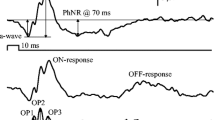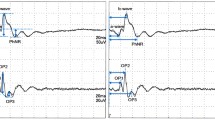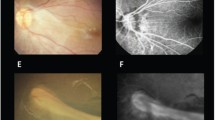Abstract
We recorded full-field electroretinograms before and after vitrectomy in 18 eyes of 18 patients with idiopathic macular hole. The results were compared between affected and fellow eyes in the preoperative and early (within 10 days) and late (3 to 6 months) postoperative periods. No significant changes between affected and control eyes were found in the amplitude of the rod electroretinogram, mixed cone-rod electroretinogram, cone electroretinogram a-and b-waves or 30-Hz flicker electroretinogram in all stages of the study. The peak implicit times of the cone electroretinogram (a-and b-wave) and dark-and light-adapted oscillatory potential (O1-O4), however, were delayed. Also, the amplitude of the oscillatory potentials (O1+O2+O3+O4) was significantly reduced in the early postoperative period. By the late period, all of these changes had resolved. We concluded that electrophysiologic changes were derived from a transitory dysfunction of the inner retina. The possible causes of the electroretinographic changes would include mechanical trauma of the surgery, intravitreous air tamponade or the changes in vitreous electrolytes after surgery. Oscillatory potentials were more sensitive than a-and b-waves in eliciting dysfunction of the inner retina in operate on eyes.
Similar content being viewed by others
References
Kelly NE, Wendel RT. Vitreous surgery for idiopathic macular holes: results of a pilot study. Arch Ophthalmol 1991; 109: 654–9.
Boldt HC, Munden PM, Folk JC, Mehaffey MG. Visual field defects after macular hole surgery. Am J Ophthalmol 1996; 122: 371–81.
Gass JDM. Idiopathic senile macular holes: its early stages and pathogenesis. Arch Ophthalmol 1988; 106:629–39.
Feghali JG, Jin J, Odom JV. Effect of short-term intraocular pressure elevation on the rabbit electroretinogram. Invest Ophthalmol Vis Sci 1991; 32: 2184–9.
Johnson MA, Drum BA, Quigley HA, Sanchez RM, Dunkelberger GR. Pattern-evoked potentials and optic nerve fiber loss in monoocular laser-induced glaucoma. Invest Ophthalmol Vis Sci 1989; 30: 897–907.
Thompson JT, Smiddy WE, Glaser BM, Sjaarda RN, Flynn HW Jr. Intraocular tamponade duration and success of macular hole surgery. Retina 1996; 16: 373–82.
Thompson JT, Glaser BM, Sjaarda RN, Murphy RP, Hanham A. Effect of intraocular bubble duration in the treatment of macular holes by vitrectomy and trasforming growth factor-beta 2. Ophthalmology 1994; 101: 1195–200.
Tornambe PE, Poliner LS, Grote K. Macular hole surgery without face-down positioning. Retina 1997; 17: 179–85.
Iwasaki T, Iwasaki H, Hishi T, Okada A, Usui M. The retinal changes following intravitreal gas injection in rabbits. ARVO abstracts. Invest Opthalmol Vis Sci 1996; 37(4.suppl): S196.
Bopp S, Lucke K, Hille U. Peripheral visual field loss after vitreous surgery for macular holes. Graefes Arch Clin Exp Ophthalmol 1997; 235: 362–71.
Marmor MF, Arden GB, Nilsson SEG, Zrenner E. Standard for clinical electroretinography. Arch Ophthalmol 1989; 107: 816–9.
Wachtmeister L. Oscillatory potential recordings. In: Heckenlively JR, Arden GB, eds. Principles and practice of clinical electrophysiology of vision. St Louis, Mosby-Year Book, 1991: 322–7.
Wendel RT, Patel AC, Kelly NE, Salzano TC, Wells JW, Novack GD. Vitreous surgery for macular holes. Ophthalmology 1993; 100: 1671–6.
Textorius O, Nilsson SEG. Effect of intraocular irrigation with melatonin on the c-wave of the direct current electroretinogram and on the standing potential of the eye in albino rabbits. Doc Ophthalmol 1987; 65: 97–111.
Textorius O, Nilsson SEG, Andersson BE. Effect of intraocular perfusion with two alternating irrigation solutions on the simultaneously recorded electroretinograrn of albino rabbits. Doc Ophthalmol 1986; 63: 349–58.
Moorhead LC, Redburn DA, Merrit J, Garcia CA. The effect of intravitreal irrigation during vitrectomy on the electroretinogram. Am J Ophthalmol 1979; 88: 239–45.
Meredith TA, Lindsey DT, Edelhauer HF, Goldman AI. Electroretinographic studies following vitrectomy and intraocular silicone oil injection. Br J Ophthalmol 1985; 69: 254–60.
Frumar KD, Gregor ZJ, Carter RM, Arden GB. Electroretinographic changes after vitrectomy and intraocular tamponade. Retina 1985; 5: 16–21.
Gouras P, Mackay CJ, Ivert L, Mittl RN, Neuwirth J, Eggers H. Computer-assisted spectral electroretinography in vitrectomy patients. Ophthalmology 1985; 92: 83–9.
Miyake Y, Yagasaki K, Horiguchi M. Electroretinographic monitoring of retinal function during eye surgery. Arch Ophthalmol 1991; 109: 1123–9.
Honda Y, Negi A, Kawano S, Takahashi Y, Chihara E. Some experimental data concerning the safety of vitrectomy. Acta Ophthalmol 1985; 63: 333–40.
Cobb WA, Morton HB. A new component of the human electroretinogram. J Physiol 1954; 123: 36–7.
Wachtmeister L. Basic research and clinical aspects of the oscillatory potential of the electroretinogram. Doc Ophthalmol 1987; 66 187–94.
Algvere P, Gjottenberg M. The diagnostic value of the oscillatory potentials of the ERG and fluorescein angiography in diabetic proliferative retinopathy. Ophthalmologica 1974; 168: 97–108.
Yonemura D, Aoki T, Tsuzuki K. Electroretinogram in diabetic retinopathy. Arch Ophthalmol 1962; 68: 19–24.
Bresnick GH, North K, Groo A, Palta M. Electroretinographic oscillatory potentials predict progression of diabetic retinopathy: preliminary report. Arch Ophthalmol 1984; 102: 1307–11.
Miyake Y, Kawase Y. Reduced amplitude of oscillatory potentials in female carrier of X-linked recessive congenital stationary night blindness. Am J Ophthalmol 1984; 98: 208–15.
Killey FP, Edlhauer HF, Aaberg TA. Intraocular fluid dynamics: measurements following vitrectomy and intraocular sulfur hexafluoride administration. Arch Ophthalmol 1980; 98: 1448–52.
Ezra E, Arden GB, Riordan-Eva P, Aylward GW, Gregor ZJ. Visual field loss following vitrectomy for stage 2 and 3 macular holes. Br J Ophthalmol 1996; 80: 519–25.
Author information
Authors and Affiliations
Rights and permissions
About this article
Cite this article
Matsumoto, C.S., Tatsukawa, T., Imaizumi, M. et al. Electroretinographic changes in eyes with idiopathic macular hole treated by vitrectomy. Doc Ophthalmol 94, 341–354 (1997). https://doi.org/10.1007/BF02580859
Accepted:
Issue Date:
DOI: https://doi.org/10.1007/BF02580859




